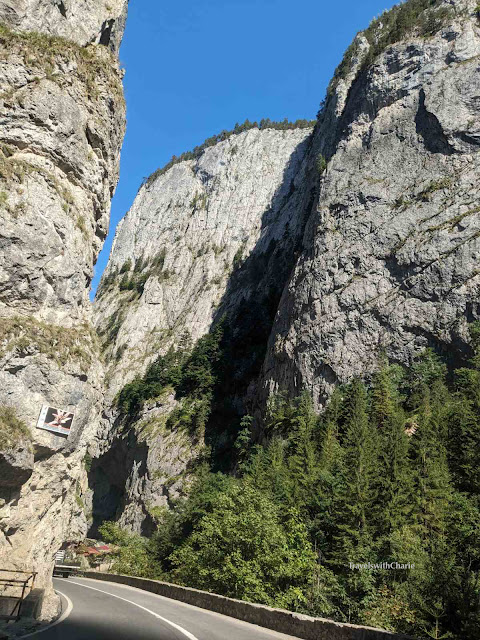Altar Rock (Pitra Altarului)
On my way to Bucovina to see the painted monasteries, I was treated to nature at its best. I never heard of Bicaz Gorge before so I had no idea what to expect. This was the most surprising part of my second visit to Romania. I was trying to take a picture of Altar Rock as we drove slowly through the pass. The goal was to make sure I got the cross on top of the limestone cliff in the frame. It’s not as clear to spot but it’s there just below the flagpole. I took this shot through the windshield as we couldn’t stop at this particular location since the pass is narrow and other cars were right behind us. Luckily I had better luck when I took the other images of the gorge.
Bicaz Gorge (Cheile Bicazului)- Hăşmaş National Park is in northeastern Romania in Neamt and Harghita counties. A winding two-lane road stretches for 8 kilometers (4.97 miles) through the gorge. Limestone walls as high as 300-400 meters (984-1312 ft.) rise on both sides of the pass. Some rocks hover so low that it looks like it might graze the rooftop of the car. What a spectacular drive it is!
Watch out for those hairpin turns!
On this particular stretch of the pass, you can stop and check out the stalls selling Romanian arts and crafts and take pictures of the canyon.
You can also get off here if you want to follow some hiking trails.
Red Lake (Lacul Rosu)
Red Lake was formed by a natural landslide in the 19th century. It’s a popular destination especially during the summer months. There are all sorts of water activities offered at the lake as well as hiking trails nearby.Pângǎrati Lake
Pângărati Lake was formed in 1964 to serve as a source for hydroelectric energy. Its waters come from both the Bistrita River and Lake Izvorul Muntelui. It is also an important natural habitat for birds, plants and fish. It’s located on the road to Bicaz Gorge in Neamt County. Bistrita Orthodox Church
Close to Bicaz Gorge, Bistrita Monastery is worth the stop for its frescoes and for the miraculous icon of St. Anne, a gift given by Lady Ana to the monastery between 1407-1408. She was the wife of the military governor, Alexandru I. The monastery is surrounded by stone walls and has an attractive inner courtyard.
How to get to Bicaz Gorge:
The best way is to rent a car so you can thoroughly explore this beautiful park. A car is also necessary to drive through the Bicazului pass. The next best thing is to join a hiking tour if you’re into hiking, mountain climbing and camping. The third option is to take the train from Bucharest or Brasov to Piatra Neamt, Gheorgheni or Bicaz. Check romaniantourism.com for more information about Bicaz Gorge. I personally traveled in Northern Romania, Ukraine and Moldova with Nicolas Experience Tours. You can check his tour programs here: experience-tours.ro
Map of Bicaz Gorge











